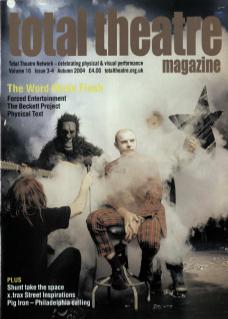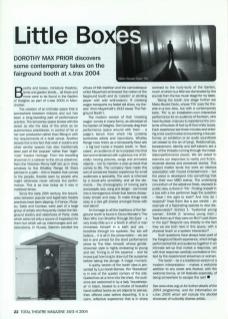Booths and boxes, miniature theatres, tents and garden sheds... all these and more were to be found in the Garden of Delights as part of x.trax 2004 in Manchester.
The creation of an intimate space that is somewhere between indoors and out has been a long-standing part of performance practice. The temporary space shares with the street as site the idea of the artist as an autonomous practitioner, in control of his or her own production rather than fitting in with the requirements of a built venue. Another streets-link is the fact that work in booths and other similar spaces has also traditionally been part of the ‘popular' rather than 'legitimate' theatre heritage. From the travelling showman in a caravan to the circus sideshow; from the Victorian Penny Gaff set up in shop windows to the Whalley Range All Stars pitched in a park – this is theatre that comes to the people, theatre seen by people who might otherwise never witness live performance. This is as true today as it was in medieval times.
Since the early 20th Century, the boundaries between popular and legitimate theatre practices have been slipping. In France, Picasso, Satie and Cocteau were part of a large group of artists who frequently visited the fairground booths and sideshows of Paris; visits which were not only a source of inspiration for them but which set up interchanges and collaborations. In Russia, Bakhtin extolled the virtues of folk tradition and the carnivalesque whilst Meyerhold embraced the notion of the fairground booth and its 'cabotin' or strolling player with wild enthusiasm: ‘A creaking wagon transports my faded old show, my theatre' (from Meyerhold's 1912 essay 'The Fairground Booth').
The modern version of that 'creaking wagon' comes in many forms, as witnessed at the Garden of Delights. Dot Comedy drag their performance space around with them – a judge's bench from which His Lordship screeches edicts and injunctions. Whalley Range have theirs as a temporarily fixed site – a big bed inside a theatre booth. In Bedcases, an audience of six is popped into that bed and entertained with a glorious mix of (literally) moving pictures, songs and animated objects – not to mention a pop-up book that comes to life. The company have made this sort of contained theatre experience for small audiences a speciality. The work is informed by a visual arts sensibility, and all the elements – the choreography of moving parts and people, text, song and design – are honed into a homogenous whole that seems deceptively simple and easy. To make things look easy is a rare gift shared amongst those with real talent!
An homage to all the traditions of the fairground booth is found in Circus Wonder's The Man Who Can Breathe Through His Eyes – a very lovely little act in a booth in which a man immerses himself in a bath and yes – breathes through his eyeballs. You too will believe... it is all in the presentation – we are led in and primed for the short performance piece by The Man himself, whose gentle-showman style is highly endearing to young and old. Timing is of the essence – and he knows just how long to draw out the suspense before taking the plunge. A magic moment.
A quirky version of the booth idea is presented by Luci Gorell-Barnes. Her Bookshed is in one of the quieter corners of the site. Guided two-at-a-time into the shed, the audience are welcomed in by a lady 'housekeeper' in black, treated to a choice of beautiful hand-crafted books-as-art-objects to peruse, then offered cake before departing. It is a calm, reflective experience that is in sharp contrast to the hurly-burly of the Garden, much of which is a little too dominated by the sounds from the live music stage for my taste.
Taking the booth one stage further are Metro Boulot Dodo, whose Fib uses the theatre-in-a-box idea, but with a contemporary twist. Fib is an installation-cum-interactive performance for an audience of fourteen, who have fourteen chances to experience the contents of fourteen eight foot by eight foot white boxes. Each experience lasts three minutes and entering a box could involve encountering a live performer, an exhibition or an audio soundtrack (all related to the art of lying). Relationships, bereavement, identity and self-esteem are a few of the threads running through the installation/performance pieces. We are asked to examine our responses to reality and fiction, received stories and perceived stories. This subject matter lends the work an obvious association with Forced Entertainment – but the piece is developed into something that has their own MBD stamp. The underlying conundrum of the sideshow freak, exposed to public view, is there in Fib. Finding oneself in a box with a live performer begs the question – Have I the right to look? And how do I respond? Treat them like a zoo exhibit – an example of a fascinating species to view dispassionately? (Exhibit 1: 'hysterical young woman'. Exhibit 2: 'anxious young man'.) Treat them as if they were on film? Look them in the eye? Respond very directly to the fact that we are both here in this space, with a physical touch or a spoken interaction?
Such questions have always been part of the Fairground Booth experience, which brings performer/exhibit and audience together in an intimate set-up that invites a response, yet with that response carefully controlled or limited by the experienced showman or woman.
The booth – be it a traditional version or a modern interpretation – makes a welcome addition to any street arts festival, with the welcome bonus, at UK festivals especially, of being somewhere to escape the rain!
See www.xtrax.org.uk for further details of the 2004 programme, and for information on x.trax 2005 which will include the decibel showcase of culturally diverse artists.

